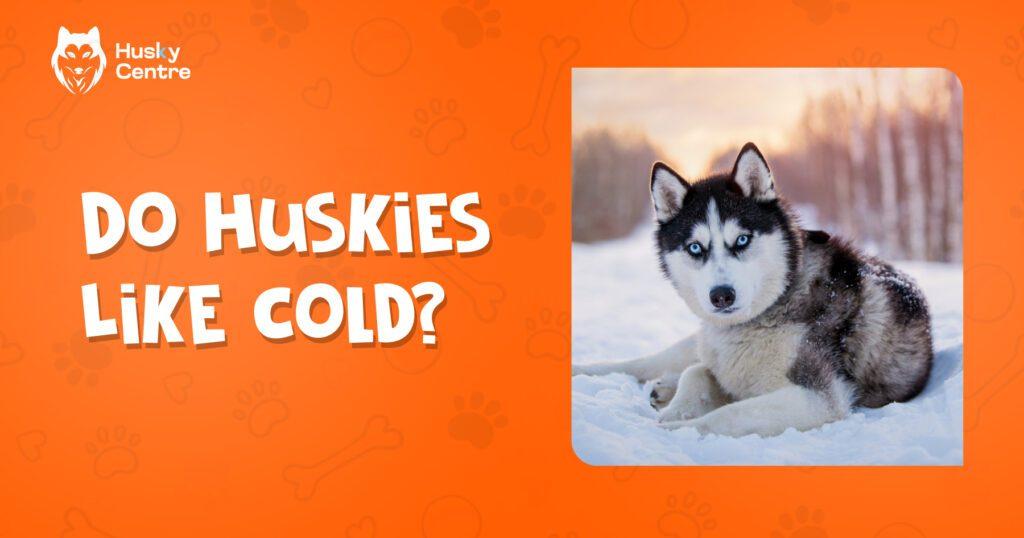Yes, Huskies love cold weather. Their thick fur coats are well-suited for cold climates.
Huskies thrive in cold weather due to their dense double coats. Originating from Siberia, they are naturally adapted to withstand freezing temperatures. Their outer coat repels snow and ice, while the inner coat provides insulation. These physical traits make them enjoy and perform well in cold environments.
Huskies are energetic and playful, and they find snowy terrains perfect for their activities. Owners should ensure they get enough exercise and mental stimulation. Cold weather offers them the ideal conditions to stay active and healthy. Proper care and attention to their needs can help Huskies live a happy, fulfilling life in colder climates.
Siberian Husky Origins
The majestic Siberian Husky is known for its stunning looks and resilient nature. Many wonder, do Huskies like the cold? To understand this, we need to explore their fascinating origins. Siberian Huskies were bred to withstand harsh weather, and their history reveals why they thrive in chilly environments.
Siberian Huskies originate from Northeast Asia, specifically the Chukchi Peninsula in Russia. The Chukchi people, indigenous to this area, bred these dogs for their endurance and ability to pull sleds over long distances.
Huskies were essential to the Chukchi way of life. They were used for transportation, helping the Chukchi traverse the icy tundra. These dogs had to be resilient, strong, and able to endure extreme cold.
Adaptations To Cold Weather
Their thick double coat plays a key role in their adaptation. The undercoat is soft and dense, providing insulation. The outer coat is longer and water-resistant, protecting them from snow and ice.
Huskies also have a unique metabolic system. They can efficiently use their energy, allowing them to run for hours without getting tired. This is vital in freezing conditions where energy conservation is crucial.
Huskies have strong, muscular bodies. Their almond-shaped eyes are often blue or multi-colored, adding to their striking appearance. They have erect triangular ears and a bushy tail that curls over their back, helping to keep them warm.
| Feature | Description |
| Coat | Thick double coat |
| Eyes | Blue, brown, or multi-colored |
| Ears | Erect and triangular |
| Tail | Bushy and curled |
Huskies are known for their friendly and outgoing nature. They are social animals that enjoy the company of humans and other dogs. Their playful demeanor makes them excellent family pets.
Despite their friendly nature, Huskies are also independent. They can be stubborn and require consistent training. This independence is a trait that helped their ancestors survive in the harsh arctic conditions.
Modern-day Huskies
Today, Huskies are popular as pets and working dogs. They participate in sled dog races, showcasing their endurance and speed. Their ability to thrive in cold climates remains, making them well-suited for families in cooler regions.
Understanding the origins and traits of Siberian Huskies helps explain why they love the cold. Their history and physical attributes make them perfect for icy adventures.
Historical Roles In Cold Climates
Huskies are known for their love of cold weather. Their thick fur and strong build make them perfect for icy climates. Understanding their historical roles in cold climates helps explain why they thrive in low temperatures.
Early Domestication And Use
Huskies were first domesticated by the Chukchi people in Siberia. These dogs were essential for survival in harsh, cold environments. They helped with transportation and hunting, making them invaluable to their owners.
Sled Dogs In The Arctic
Huskies became famous as sled dogs in the Arctic region. Their endurance and ability to pull heavy loads over long distances were unmatched. They were used in various expeditions and races, showcasing their strength and resilience.
Military And Exploration Missions
During World War II, Huskies served in military operations. They were used for search and rescue missions in snowy terrains. Explorers also relied on them for Arctic expeditions, trusting their ability to navigate through ice and snow.
Modern-day Roles
Today, Huskies still participate in sled dog races and winter sports. Their historical roles in cold climates continue to influence their popularity. They remain a symbol of strength, endurance, and adaptability in freezing conditions.
Adaptations To Harsh Environments
Huskies are known for their love of cold weather. They thrive in snowy and icy conditions. Their bodies have unique features that help them survive in harsh environments. Let’s dive into these amazing adaptations.
1. Double Coat
The Husky’s fur is one of their greatest assets. They have a thick double coat that keeps them warm. The undercoat is soft and dense, trapping heat close to their bodies. The topcoat is made up of longer, water-resistant hairs. This protects them from snow and ice.
2. Fur Between Their Toes
Huskies have fur between their toes. This helps them walk on snow and ice. The fur provides extra grip, preventing them from slipping. It also acts as insulation for their paws, keeping them warm.
3. High Metabolism
Huskies have a high metabolism. This means they generate a lot of body heat. They can run for hours without getting tired. This helps them stay warm, even in freezing temperatures.
4. Thick Skin
The skin of a Husky is thicker than that of other dogs. This provides another layer of insulation. It helps keep their bodies warm. This thick skin is especially useful in windy conditions.
5. Unique Blood Flow
Huskies have a special circulatory system. Blood vessels in their legs and paws exchange heat. Warm blood from their body warms up the cooler blood in their extremities. This prevents their paws from freezing.
| Adaptation | Description |
| Double Coat | Thick fur with an insulating undercoat and water-resistant topcoat. |
| Fur Between Toes | Extra grip and insulation for paws. |
| High Metabolism | Generates body heat for long periods. |
| Thick Skin | Provides additional insulation. |
| Unique Blood Flow | Prevents extremities from freezing. |
Physical Characteristics
Huskies are known for their love of cold weather. Their physical characteristics make them well-suited to thrive in chilly climates. These traits ensure they stay warm and comfortable even in harsh winter conditions.
Thick Double Coat
Huskies have a thick double coat that keeps them warm. This coat consists of two layers:
- Undercoat: The soft, dense undercoat provides insulation. It traps air and helps keep the husky’s body heat in.
- Topcoat: The topcoat is made of longer, water-resistant guard hairs. These protect the dog from snow, ice, and moisture.
During winter, the undercoat grows thicker. In summer, huskies shed this layer to stay cool. This process is called “blowing the coat.”
Regular grooming helps manage shedding and keeps the coat healthy. A well-maintained coat is crucial for their comfort in cold weather.
Body Structure And Insulation
Huskies have a unique body structure that aids in insulation. Their bodies are compact and muscular, which helps retain heat. Some key features include:
- Compact body: A smaller surface area reduces heat loss.
- Muscular build: Muscles generate heat and provide extra warmth.
- Thick skin: The skin has a layer of fat that offers additional insulation.
These physical traits make huskies well-equipped to handle cold weather. They can run and play in the snow without feeling too cold.
Paw Adaptations For Snow And Ice
Huskies’ paws are adapted to handle snow and ice. Their paws have several special features:
- Thick pads: The pads protect their feet from cold surfaces and sharp ice.
- Fur between toes: Fur grows between their toes, providing extra warmth and traction.
- Non-slip pads: Their pads have a rough texture that helps prevent slipping on ice.
A husky’s paws are also more resistant to frostbite. This means they can walk and run on icy terrain without getting injured.
These adaptations ensure huskies stay comfortable and safe in snowy environments. They can enjoy winter activities with ease, thanks to their specialized paws.
Behavioral Traits
Huskies are known for their love of cold weather. Their behavioral traits reflect their origins in cold climates. These dogs exhibit behaviors that demonstrate their comfort and joy in colder environments.
Cold-weather Activities Huskies Enjoy
Huskies thrive in cold weather and enjoy various activities that keep them active and engaged. Here are some cold-weather activities Huskies love:
- Sledding: Huskies have a natural affinity for pulling sleds. This activity allows them to use their strength and endurance.
- Snow play: Huskies enjoy playing in the snow. They love to dig, jump, and roll around in the fluffy white powder.
- Hiking: Cold weather hikes are perfect for Huskies. They can trek through snowy trails with ease and enthusiasm.
- Running: Huskies have a high energy level. Running in the cold helps them burn off excess energy and stay fit.
These activities not only keep Huskies physically active but also mentally stimulated.
Natural Instincts And Behaviors In Cold Environments
Huskies have several natural instincts and behaviors that make them well-suited for cold environments:
- Thick fur coat: Huskies have a double-layered coat. The undercoat provides insulation, while the outer coat repels snow and water.
- Paw pads: Huskies have tough paw pads that protect them from cold surfaces. This allows them to walk on ice and snow without discomfort.
- Burrowing: In cold weather, Huskies may dig into the snow to create a cozy burrow. This behavior helps them stay warm.
- Pack mentality: Huskies often huddle together in cold weather. This behavior provides warmth and comfort.
These instincts and behaviors have been honed over generations, making Huskies excellent cold-weather companions.
Comparison With Other Breeds
Huskies have distinct cold-weather traits compared to other breeds. Here’s a comparison with some popular breeds:
| Trait | Huskies | Other Breeds |
| Fur coat | Double-layered for insulation | Varies; some have single coats |
| Energy levels | High energy, loves running | Varies; some breeds are less active |
| Cold tolerance | Highly tolerant | Varies; many prefer warmer climates |
| Behavior in snow | Loves playing and burrowing | Some breeds dislike snow |
Huskies are uniquely adapted to cold environments. Their behavioral traits make them stand out among other breeds in such conditions.
Health Benefits Of Cold Weather
Huskies are known for their love of cold weather. This breed thrives in colder climates, and the chill brings numerous health benefits. Understanding these advantages can help Husky owners ensure their pets remain healthy and happy.
Impact On Husky’s Overall Health
Cold weather positively impacts a Husky’s overall health. These dogs have dense double coats that provide insulation and protect them from the cold. Cold temperatures help regulate their body temperature and reduce the risk of overheating.
Key health benefits include:
- Improved cardiovascular health: Cold weather promotes increased blood circulation.
- Enhanced respiratory function: Cooler air is easier for Huskies to breathe.
- Stronger immune system: Exposure to cold can strengthen their immune defenses.
Note: Ensure your Husky is acclimated to cold weather gradually. Sudden exposure can lead to health issues.
Benefits For Joint And Muscle Function
Cold weather offers significant benefits for a Husky’s joints and muscles. These dogs are highly active and enjoy running and playing in the snow. The cold provides a natural environment for them to exercise without overheating.
Key benefits for joints and muscles include:
- Reduced inflammation: Cold temperatures can decrease inflammation in joints.
- Increased mobility: Huskies tend to move more freely in cooler climates.
- Strengthened muscles: Regular activity in the cold helps build muscle strength.
Exercise Tips: Allow your Husky to play in the snow or take them for brisk walks. This helps maintain their muscle tone and joint health.
Cold Weather And Energy Levels
Cold weather significantly affects a Husky’s energy levels. These dogs are bred for endurance and have high energy needs. The cold environment keeps them active and alert.
Impact on energy levels:
- Increased stamina: Huskies can run for longer periods without tiring.
- Enhanced playfulness: They tend to be more playful and enthusiastic in the cold.
- Better mental stimulation: Cold weather activities stimulate their minds.
Activity Ideas: Engage your Husky in snowball fetch or set up obstacle courses in the snow. These activities keep their energy levels high and provide mental stimulation.
Risks And Considerations
Huskies are known for their love of cold weather. They have thick fur coats that make them well-suited for low temperatures. But even these hardy dogs can face risks in extreme cold. Understanding these risks and taking the right precautions can keep your Husky safe and happy during winter.
Potential Risks Of Extreme Cold
While Huskies enjoy cold weather, extreme cold poses several risks. Even with their thick fur, prolonged exposure to severe cold can be harmful. Here are some potential risks:
- Hypothermia: This occurs when a dog’s body temperature drops too low. It can lead to serious health issues.
- Frostbite: Frostbite damages the skin and tissues. It often affects extremities like ears, paws, and tails.
- Dehydration: Cold air can be dry, causing your Husky to lose moisture faster.
- Salt and chemicals: Road salt and de-icing chemicals can irritate and damage your Husky’s paws.
It’s essential to recognize these risks and take measures to mitigate them. Monitoring your Husky’s exposure to cold weather can prevent these issues.
Signs Of Hypothermia Or Frostbite In Huskies
Recognizing the signs of hypothermia or frostbite early can save your Husky from severe health problems. Here are some signs to watch for:
| Condition | Signs |
| Hypothermia | ShiveringWeaknessLow energyPale gumsSlow breathing |
| Frostbite | Pale or gray skinCold and hard skinSwellingBlistersBlackened skin |
If you notice any of these signs, take immediate action. Warm your Husky gently and consult a vet as soon as possible.
Precautions For Winter Activities
Winter activities can be fun for Huskies, but precautions are necessary to keep them safe. Here are some steps you can take:
- Limit exposure: Avoid leaving your Husky outside for long periods.
- Use dog booties: These protect your Husky’s paws from cold and harmful chemicals.
- Provide shelter: Ensure your Husky has a warm place to stay when outside.
- Monitor hydration: Make sure your Husky drinks enough water. Cold weather can be dehydrating.
- Check their paws: After walks, check your Husky’s paws for any signs of injury or irritation.
By taking these precautions, you can ensure your Husky enjoys winter safely. Always stay attentive to their needs and well-being.
Husky Care In Cold Weather
Huskies are famous for their stunning appearance and boundless energy. These dogs thrive in cold climates due to their thick double coats. Proper care is crucial to ensure their well-being during the winter months.
Tips For Outdoor Activities In Winter
Huskies love playing outside, especially in the snow. Here are some tips to ensure your Husky enjoys winter activities safely:
- Monitor activity levels: Huskies are energetic, so keep an eye on them to avoid overexertion.
- Choose suitable times: Avoid the coldest parts of the day. Aim for late morning or early afternoon walks.
- Use reflective gear: Winter days are short. Use reflective collars and leashes to keep your Husky visible.
- Protect their paws: Snow and ice can damage paws. Use paw wax or booties for protection.
- Stay hydrated: Huskies need water even in winter. Carry a portable bowl and fresh water.
| Activity | Recommended Duration |
| Snow Play | 30-45 minutes |
| Winter Hiking | 1-2 hours |
| Sledding | 1 hour |
Proper Grooming And Coat Care
Huskies have a thick double coat that requires regular care. Proper grooming helps maintain their health and comfort in cold weather:
- Brush regularly: Brush your Husky’s coat at least twice a week to remove loose fur and prevent matting.
- Check for mats and tangles: Mats can cause discomfort and skin issues. Remove them gently with a detangling spray.
- Bathe sparingly: Overbathing can strip natural oils. Bathe your Husky every few months or when necessary.
- Dry thoroughly: After bathing, ensure your Husky is completely dry to prevent chills.
- Inspect for pests: Cold weather doesn’t eliminate pests. Check for ticks and fleas during grooming sessions.
Providing Adequate Shelter And Warmth
Huskies can tolerate cold, but they still need proper shelter and warmth during winter:
- Insulate their shelter: Use straw or thermal blankets to insulate dog houses.
- Elevate the shelter: Keep the dog house off the ground to prevent cold and dampness.
- Use heated pads: Heated dog pads or beds can provide extra warmth.
- Ensure ventilation: Proper ventilation prevents moisture buildup inside the shelter.
- Provide indoor access: Allow your Husky to come inside during extreme cold or severe weather.
| Shelter Feature | Benefit |
| Insulation | Keeps warm and dry |
| Elevation | Prevents dampness |
| Heated Pads | Provides extra warmth |
| Ventilation | Reduces moisture |
Frequently Asked Questions
How Cold Is Too Cold For Huskies?
Huskies can tolerate temperatures as low as -60°F (-51°C). Ensure they have proper shelter and care in extreme cold.
Are Huskies Happier In Cold Weather?
Yes, Huskies are happier in cold weather. Their thick fur coats are designed for snowy and cold environments. They thrive in cooler temperatures and enjoy outdoor activities in the snow.
Are Huskies Scared Of Cold?
No, Huskies are not scared of the cold. They thrive in cold climates due to their thick fur.
How Do Huskies’ Paws Not Freeze?
Huskies’ paws have a specialized circulation system. Warm blood flows to the paws, preventing them from freezing. Their thick pads and fur also provide insulation against the cold.
Conclusion
Huskies thrive in cold climates, thanks to their thick fur and natural adaptation. They enjoy snow and chilly weather. Always ensure your husky stays comfortable and healthy. Whether you live in a cold region or not, understanding their needs is crucial.
Keep them happy, and they’ll be your loyal companion.


Meet Jarred, the heart and soul behind HukyCentre. With a deep affection for furry friends, he pours his passion into every word he writes. His genuine love for dogs shines through in his engaging and informative content. As a dedicated dog enthusiast, Jarred’s goal is to share valuable insights and tips that resonate with fellow dog lovers. Join Jarred on the journey as he celebrates the joy and companionship that dogs bring into our lives.



